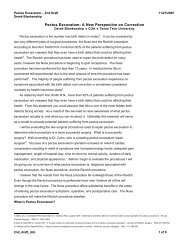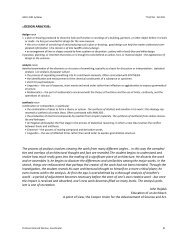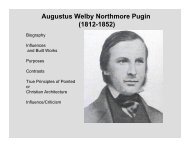What is a 5 Paragraph Essay
What is a 5 Paragraph Essay
What is a 5 Paragraph Essay
Create successful ePaper yourself
Turn your PDF publications into a flip-book with our unique Google optimized e-Paper software.
5 <strong>Paragraph</strong> <strong>Essay</strong>: The Persuasive Argument Spring 2009<br />
5 <strong>Paragraph</strong> <strong>Essay</strong>: The Persuasive Argument<br />
<strong>What</strong> <strong>is</strong> a 5 <strong>Paragraph</strong> <strong>Essay</strong>?<br />
Five <strong>Paragraph</strong> was once taught as the most handy way to explain the writing process<br />
to composition students, the five paragraph essay helps students - both in school and<br />
in life - by giving them an easy-to-apply device for saying what needs to be said clearly<br />
and conc<strong>is</strong>ely. Since the vast majority of professors in composition classes teach and<br />
encourage the five paragraph essay, it <strong>is</strong> important for students to understand its<br />
structure and usefulness as well as its limitations.<br />
The structure of the five paragraph essay <strong>is</strong> very simple. It cons<strong>is</strong>t of 5 different<br />
paragraphs<br />
Introduction:<br />
Introductory <strong>Paragraph</strong><br />
The introductory paragraph <strong>is</strong> the a kind of thes<strong>is</strong> statement, it's a short-outline for the<br />
paper, it tells the reader what the essay <strong>is</strong> about.<br />
Thes<strong>is</strong>: Claim based on Reasons supported by Evidence.<br />
Body <strong>Paragraph</strong> 1<br />
The Body <strong>Paragraph</strong> one should start with a main topic sentence or opening statement,<br />
which lead the reader into the first piece of evidence to support your thes<strong>is</strong> statement.<br />
It <strong>is</strong> essentially a mini-thes<strong>is</strong> for the paragraph. Your argument must be properly cited<br />
to support your evidence. Th<strong>is</strong> evidence must all revolve around a single theme and<br />
should come in the form of a quotation If you put too many different themes into one<br />
body paragraph, then the essay becomes confusing. Finally, fin<strong>is</strong>h the paragraph with<br />
a concluding sentence summing up only what you have d<strong>is</strong>cussed in that paragraph.<br />
Body <strong>Paragraph</strong> 2<br />
Almost same as Body <strong>Paragraph</strong> 1 , but you provide more evidence and cite them to<br />
support you point.<br />
Body <strong>Paragraph</strong> 3<br />
Same as <strong>Paragraph</strong> 1 and 2.<br />
Conclusion<br />
In conclusion you try to convince the reader that you have provided enough proof to<br />
support you points and sentences you have written in the upper paragraphs. You are<br />
allowed to be confident here, and you are even allowed to drop little extra pieces of<br />
information that make the reader think more than you previewed in the entire paper. It<br />
<strong>is</strong> also important to have a concluding mini-thes<strong>is</strong> in th<strong>is</strong> paragraph. Th<strong>is</strong> statement <strong>is</strong><br />
the closing tag-line, the "see what I just did" idea in every paper. An essay can be<br />
immaculately written, organized, and researched; however, without a conclusion, the<br />
reader <strong>is</strong> left dumbfounded, frustrated, confused.<br />
5<strong>Paragraph</strong><strong>Essay</strong>_Argument.doc 1 of 5
5 <strong>Paragraph</strong> <strong>Essay</strong>: The Persuasive Argument Spring 2009<br />
The following <strong>is</strong> extracted for the website<br />
http://www.gc.maricopa.edu/Engl<strong>is</strong>h/essay/table.html 8/30/2006<br />
Outline of the Five-<strong>Paragraph</strong> “Persuasive Argument” <strong>Essay</strong><br />
1. Introductory <strong>Paragraph</strong><br />
a. Motivator<br />
b. Thes<strong>is</strong> Sentence<br />
c. Blueprint<br />
2. First Body <strong>Paragraph</strong><br />
a. 1 st Reason – Topic Sentence<br />
b. Support Evidence<br />
c. Support Evidence<br />
d. Support Evidence<br />
3. Second Body <strong>Paragraph</strong><br />
a. 2 nd Reason - Topic Sentence<br />
b. Support Evidence<br />
c. Support Evidence<br />
d. Support Evidence<br />
4. Third Body <strong>Paragraph</strong><br />
a. 3 rd Reason - Topic Sentence<br />
b. Support Evidence<br />
c. Support Evidence<br />
d. Support Evidence<br />
5. Concluding <strong>Paragraph</strong><br />
a. Reworded Thes<strong>is</strong><br />
b. Clincher<br />
Expanded Five <strong>Paragraph</strong> <strong>Essay</strong> - EXAMPLE<br />
1. Introductory <strong>Paragraph</strong><br />
People are m<strong>is</strong>taken who believe the high Rockies are hard to<br />
climb. To the traveler who has passed through the plains of<br />
Kansas and eastern Colorado, the high Rockies might seem<br />
like a beautiful but forbidding wilderness, approachable by<br />
only the toughest mountaineers. It <strong>is</strong> true that the 53 peaks in<br />
the Rockies that soar over 14,000 feet in elevation should<br />
only be attempted by seasoned climbers. However, the peaks<br />
under 14,000 feet, the fourteeners, can be easily climbed by<br />
the average person. Actually, climbing Colorado's<br />
fourteeners <strong>is</strong> hardly a rugged experience because most of<br />
them take only a day to climb, involve no more than hiking<br />
and simple scrambling, and are conquered by many people<br />
each year.<br />
5<strong>Paragraph</strong><strong>Essay</strong>_Argument.doc 2 of 5
5 <strong>Paragraph</strong> <strong>Essay</strong>: The Persuasive Argument Spring 2009<br />
2. First Body <strong>Paragraph</strong><br />
Surpr<strong>is</strong>ingly, unlike expeditions to Mt. McKinley or Mt.<br />
Everest, a climb up one of Colorado's 14,000 foot peaks rarely<br />
takes more than a day. Pike's Peak, with the state's greatest<br />
base-to-summit elevation gain, <strong>is</strong> admittedly a strenuous<br />
climb, yet a retired college professor in h<strong>is</strong> middle seventies<br />
makes the hike every day in the summer. A friend of mine,<br />
Carson Black, in a day, once climbed four fourteeners, three<br />
of which--Crestone Peak, Crestone Needle, and Kit Carson<br />
Peak--are the most challenging in the state. Even more<br />
revealing <strong>is</strong> the Bicentennial celebration by the Colorado<br />
Mountain Club. It planned to have members on the summit of<br />
every fourteener in the state on July 4, 1976. Only a handful<br />
of ascents took more than a day.<br />
3. Second Body <strong>Paragraph</strong><br />
Colorado's 14,000-foot peaks are also fairly easy to climb<br />
because they require no special climbing techniques. The<br />
"knife-edge traverse" on Capitol Peak <strong>is</strong> probably the most<br />
infamous challenge, yet most hikers who carry ropes don't<br />
use them when they see the ridge <strong>is</strong> not very intimidating.<br />
The highest peak in the state, Mt. Elbert, <strong>is</strong> so simple to climb<br />
that a jeep made it in 1949, and one man "rode a 24-year-old<br />
bicycle to the summit in 1951" (Perry Eberhart and Philip<br />
Schmuck, The Fourteeners, p. 38). I personally saw two<br />
motorcycles on the 14,000-foot ridge between Mt. Democrat and Mt. Lincoln.<br />
4. Third Body <strong>Paragraph</strong><br />
Another indication that climbing Colorado's highest peaks <strong>is</strong><br />
not very difficult <strong>is</strong> the sheer number of people who succeed<br />
each summer. After descending from Torrey's Peak one<br />
weekend in August, I counted over seventy cars in the<br />
parking lot. On a week the previous August, I passed fifty<br />
people in various stages of climbing Mt. Elbert. Even years<br />
ago--in 1968--4226 people climbed Longs Peak (Paul W.<br />
Nesbit, Longs Peak, p. 68). Its parking lot today, to<br />
accommodate the number of climbers, <strong>is</strong> about a quarter-mile<br />
long.<br />
5. Concluding <strong>Paragraph</strong><br />
If I've shattered your belief that Colorado's peaks are the domain of only bears and<br />
mountain men who look like bears, consider how Zebulon Pike might feel about Pikes<br />
Peak today. In 1806, he "predicted that the mountain would never be climbed" (Eberhart<br />
and Schmuck, p. 6). Now, via the cog railway or the toll highway, he could reach the<br />
summit without moving h<strong>is</strong> legs.<br />
5<strong>Paragraph</strong><strong>Essay</strong>_Argument.doc 3 of 5
5 <strong>Paragraph</strong> <strong>Essay</strong>: The Persuasive Argument Spring 2009<br />
Structure of a 5 <strong>Paragraph</strong> Argument<br />
Introductory <strong>Paragraph</strong><br />
Motivator: People are m<strong>is</strong>taken who believe the high Rockies are hard to<br />
climb.<br />
Thes<strong>is</strong>: Climbing Colorado's fourteeners <strong>is</strong> hardly a rugged<br />
experience...<br />
Blueprint: ...most of them take only a day to climb, involve only hiking<br />
and simple scrambling, and are conquered by many people<br />
every year.<br />
Introductory <strong>Paragraph</strong><br />
People are m<strong>is</strong>taken who believe the high Rockies are hard to climb. To the<br />
traveler who has passed through the plains of Kansas and eastern Colorado, the<br />
high Rockies might seem like a beautiful but forbidding wilderness,<br />
approachable by only the toughest mountaineers. It <strong>is</strong> true that the 53 peaks in<br />
the Rockies that soar over 14,000 feet in elevation should only be attempted by<br />
seasoned climbers. However, the peaks under 14,000 feet, the fourteeners, can<br />
be easily climbed by the average person. Actually, climbing Colorado's<br />
fourteeners <strong>is</strong> hardly a rugged experience because most of them take only a day<br />
to climb, involve no more than hiking and simple scrambling, and are conquered<br />
by many people each year.<br />
First Body <strong>Paragraph</strong><br />
Topic Sentence A climb up one of Colorado's 14,000 foot peaks rarely<br />
more than a day.<br />
Support Evidence Old professor makes daily climbs.<br />
Support Evidence A friend climbed four in one day.<br />
Support Evidence Colorado Mountain Club climbed most of the state's<br />
fourteeners in a day to celebrate the Bicentennial.<br />
Surpr<strong>is</strong>ingly, unlike expeditions to Mt. McKinley or Mt. Everest, a climb up one of<br />
Colorado's 14,000 foot peaks rarely takes more than a day. Pike's Peak, with the<br />
state's greatest base-to-summit elevation gain, <strong>is</strong> admittedly a strenuous climb,<br />
yet a retired college professor in h<strong>is</strong> middle seventies makes the hike every day<br />
in the summer. A friend of mine, Carson Black, in a day, once climbed four<br />
fourteeners, three of which--Crestone Peak, Crestone Needle, and Kit Carson<br />
Peak--are the most challenging in the state. Even more revealing <strong>is</strong> the<br />
Bicentennial celebration by the Colorado Mountain Club. It planned to have<br />
members on the summit of every fourteener in the state on July 4, 1976. Only a<br />
handful of ascents took more than a day.<br />
5<strong>Paragraph</strong><strong>Essay</strong>_Argument.doc 4 of 5
5 <strong>Paragraph</strong> <strong>Essay</strong>: The Persuasive Argument Spring 2009<br />
Second Body <strong>Paragraph</strong><br />
Topic Sentence Colorado's 14,000-foot peaks are easy to climb.<br />
Support Evidence The "knife-edge traverse" on Capitol Peak <strong>is</strong> a challen<br />
ropes aren't usually used.<br />
Support Evidence The highest peak in the state, Mt. Elbert, <strong>is</strong> simple to c<br />
Support Evidence I personally saw two motorcycles on the 14,000-foot ri<br />
Colorado's 14,000-foot peaks are also fairly easy to climb because they require<br />
no special climbing techniques. The "knife-edge traverse" on Capitol Peak <strong>is</strong><br />
probably the most infamous challenge, yet most hikers who carry ropes don't<br />
use them when they see the ridge <strong>is</strong> not very intimidating. The highest peak in<br />
the state, Mt. Elbert, <strong>is</strong> so simple to climb that a jeep made it in 1949, and one<br />
man "rode a 24-year-old bicycle to the summit in 1951" (Perry Eberhart and<br />
Philip Schmuck, The Fourteeners, p. 38). I personally saw two motorcycles on<br />
the 14,000-foot ridge between Mt. Democrat and Mt. Lincoln.<br />
Third Body <strong>Paragraph</strong><br />
Topic Sentence Many climb peaks each year.<br />
Support Evidence I saw over seventy cars in the parking lotof Torrey's P<br />
Support Evidence I passed fifty people climbing Mt. Elbert.<br />
Support Evidence In 1968, 4226 people climbed Longs Peak.<br />
Another indication that climbing Colorado's highest peaks <strong>is</strong> not very difficult <strong>is</strong><br />
the sheer number of people who succeed each summer. After descending from<br />
Torrey's Peak one weekend in August, I counted over seventy cars in the<br />
parking lot. On a week the previous August, I passed fifty people in various<br />
stages of climbing Mt. Elbert. Even years ago--in 1968--4226 people climbed<br />
Longs Peak (Paul W. Nesbit, Longs Peak, p. 68). Its parking lot today, to<br />
accommodate the number of climbers, <strong>is</strong> about a quarter-mile long.<br />
Concluding <strong>Paragraph</strong><br />
Reworded Thes<strong>is</strong>: I've probably shattered your belief that Colorado's pea<br />
the domain of only bears and mountain men who look<br />
bears<br />
Clincher: Zebulon Pike would be surpr<strong>is</strong>ed today.<br />
If I've shattered your belief that Colorado's peaks are the domain of only bears<br />
and mountain men who look like bears, consider how Zebulon Pike might feel<br />
about Pikes Peak today. In 1806, he "predicted that the mountain would never<br />
be climbed" (Eberhart and Schmuck, p. 6). Now, via the cog railway or the toll<br />
highway, he could reach the summit without moving h<strong>is</strong> legs.<br />
5<strong>Paragraph</strong><strong>Essay</strong>_Argument.doc 5 of 5
















